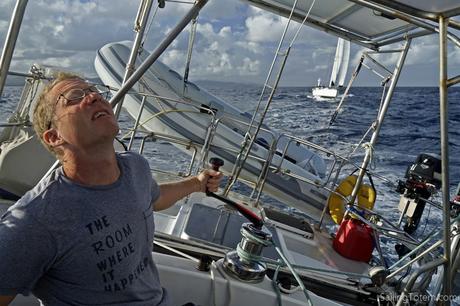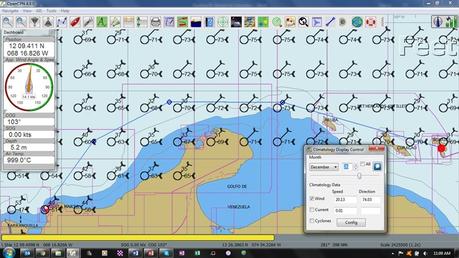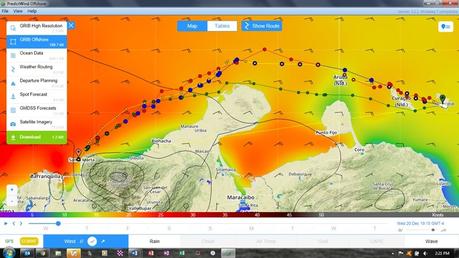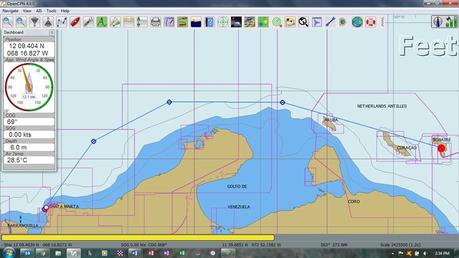
There is a good chance our upcoming passage will suck. Yay…
How do we know it’s not a simple downwind run in the trades? Enough friends, cruisers with miles, have told us how uncomfortable the stretch across the top of South America to give credence to the oft-repeated quote that this is one of the “five worst passages.” That quote is never sourced (if anyone knows a legit data source, please add in comments or contact me!) but experiences show there’s more to it than hyperbole.
How are we going to mitigate the misery? Jamie’s outlined our planning process as an exercise for the people working with us as cruising coaches. A summary of planning factors are and shared via email and our coaching Facebook group. We’ve helped as coaches with information on identifying tools to use, sources to check, questions to ask for developing a plan, as well as fleshed out details that make up the dynamics of this route. The exercise is broken into parts over a few days to facilitate discussion on different aspects in the safe space of the closed group, where there are no dumb questions or tridents thrown by Salty McSaltypants. What follows is pared back version of this exercise-turned-teaching-tool.
Passage Planning Basics
Totem lies in Bonaire over a pretty coral reef, safely secured to a mooring. Next stop: Santa Marta, Colombia! This is the planned route:

The route: Bonaire to Santa Marta, Colombia
YOUR TASK:
- Assess passage for risks
- Learn historical conditions AND track current conditions
- Develop a safe, efficient route
- Identify the weather window to depart in
- identify BAILOUT options, should an issue require getting into port sooner
- Know destination clearance processes
- Prepare a float plan, if passage complexity necessitates it
At this point, coaching clients are asked to think about what they’d do: to pretend it’s their own passage. Identify tools, research conditions, create a plan, and especially: ask questions! They can document for feedback, discuss on our coaching Facebook group, or just let it sink in as future fodder. Below are the top notes of information shared back with them.
1 – Assess risks
Every passage has them; these are particular to our transit from Bonaire and Colombia. The purpose is to break them down and think about how they impact planning.
Dangerous waves: Comfort underway is all about the sea state. Three factors set up risk here: 1) a long fetch creating bigger waves, 2) deep water bunching at the continental shelf, and 3) strong katabatic winds.
Shipping: This is the highway to/from Panama Canal. The radar and AIS will get a lot of use watching out for traffic!
Debris in Water: River outflows send floating mats of weed and large deadheads; it’s also the leeward end of Caribbean Sea. Risk of hitting debris is higher, especially closer to the coast.
Security: Colombia and Venezuela present security risks of different dynamics, with aggressive incidents at sea and coastally.
2 – Historical weather and current conditions
Historical weather first! It trends in three-month periods, alternating between rough and calm conditions. December to February has rough conditions – lucky us! (It’s a choice. It’s always a choice.) Key dynamics are the prevailing trade winds, from the east (speeds increase in the western part of the sea), and strong katabatic winds off mountains on the continent. These katabatic winds can create sever conditions, including rough/confused seas. Helping Totem along: there should be a positive current, up to 2 knots at times, for the first 12-24 hours. It may not help the sea state, though.
Now current weather conditions: this is a complex 2 to 3 day passage. Begin watching weather well in advance to look for patterns. Look for systems that disrupt/ease prevailing trade winds/waves. The katabatic winds aren’t well integrated to GRIB models. PredictWind has more detail along the coastline, but may understate their effect.
Watch the currents for flow pattern – is it linear or disjointed? Will you have to navigate eddies and meanders? Now that we’re in countdown mode, weather and current are closely tracked to make a go, no-go decision.

OpenCPN with Climatology plugin overlay
Sources
Historical weather trend data:
- Pilot Charts, like Cornell’s Cruising Ocean Atlas
- Climatology plugin for OpenCPN (shown above),
- Communication / blog posts by cruisers that have done this trip
Current weather conditions and forecast: note these are what we’re referencing on this passage. Other passages may add regional-specific sources!
- PredictWind (various models and tools)
- GMDSS (text) forecasts
- local marine forecasts
- observations for cruisers (when possible- thanks Itchy Foot!)
3 – Develop a safe, efficient route
We use PredictWind routing for an efficient path based on wind, waves, and current from four different GRIB models. The results show generally good grouping between the models, suggesting they agree on conditions. This still requires interpretation, however. Wave GRIBs are not good at representing real conditions when waves are affected by some land features; there are also the katabatic wind induced waves to consider.

PredictWind routing models based on different weather algorithms
The first third of the PredictWind route is free of increased risk we’ve noted earlier, and takes advantage of good current. Beyond that, we want to keep to deeper water – giving a wider margin to the continental shelf and mountainous headlands, and avoiding shallow banks. Hopefully this will reduce the katabatic wind affect and the chance of debris in the water. On the other hand, there will probably be more shipping traffic.
The wider route adds distance, making it roughly 400 miles. Estimating our boatspeed in these conditions, we hope to transit in a little over two days: a morning departure for a midday arrival after two nights at sea. It’s possible we’d need to slow down, as we did sailing to Bonaire from Martinique. At least the moon is waxing again, so there’ll be nice light until midnight.

If seas get sloppy close to the islands, we may go further north. OpenCPN screenshot
4 – Weather window
Watching weather for the last week plus observations from cruisers in Santa Marta to helps index what forecasts show. While the forecast is for a moderate 20 knots, to 25 knots on approach to Santa Marta, local observation is that wind is actually much stronger – up to 40 knots! Long range forecasts showing a possible window on December 26. That’s our ideal departure date, to give us a few days in Santa Marta before Jamie flies up to Puerto Rico for a rigging job. Six days out is just too far to count on at this point, but we’ll keep watching, seek local reports, and shift Totem’s plan as necessary.
5 – Bailout Options
Curacao and Aruba are options for the first part of the passage. Beyond, bailout options wane, but a helpful post on our Facebook page recommended Cabo de la Vela (thanks James!). In general, we have security concerns about stopping along Venezuela or Colombia and will avoid it if at all possible. Most passages should have multiple bailout options: find them by using guide books, charts, Coast Pilot books, and asking other cruisers.
6 – Destination clearance procedures
Outbound clearance in Bonaire is easy: one stop, one window, and they’re even going to be open on Christmas! For inbound to Colombia, the Marina Santa Marta makes it a snap. They facilitate the paperwork and cover the cruising permit, a costly process required if clearing further west at Cartagena.
7 – Float plan
I won’t get on the float plan soap box except to say – it’s important. We’ll update our existing float plan for this specific passage: download our float plan template from here.
From our crew to yours, our warmest wishes for happy holidays! We have our festive frolic going on here on Bonaire, and hope the weather window holds for a departure on the 26th.

